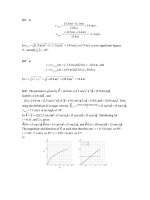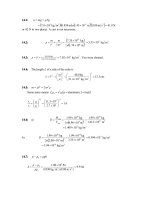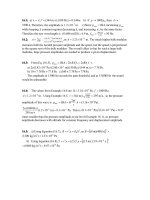- Trang chủ >>
- Khoa Học Tự Nhiên >>
- Vật lý
Tài liệu Physics exercises_solution: Chapter 18 doc
Bạn đang xem bản rút gọn của tài liệu. Xem và tải ngay bản đầy đủ của tài liệu tại đây (244.66 KB, 29 trang )
In doing the numerical calculations for the exercises and problems for this chapter, the
values of the ideal-gas constant have been used with the precision given on page 501 of
the text,
K.molatmL0.08206KmolJ3145.8 R
Use of values of these constants with either greater or less precision may introduce
differences in the third figures of some answers.
18.1: a)
mol.3.56)molkg10400(kg)225.0(
3
tot
Mmn
b) Of the many ways
to find the pressure, Eq. (18.3) gives
Pa.106.81atm67.2
L)(20.0
K)K)(291.15molatmL06mol)(0.0823.56(
6
V
nRT
p
18.2: a) The final temperature is four times the initial Kelvin temperature, or 4(314.15
K) –273.15=
C983
to the nearest degree.
kg.1024.5
)K15.314)(Katm/molL08206.0(
)L60.2)(atm30.1)(kg/mol1000.4(
b)
4
3
tot
RT
MpV
nMm
18.3: For constant temperature, Eq. (18.6) becomes
atm.96.0)390.0110.0)(atm40.3()(
2112
VVpp
18.4: a) Decreasing the pressure by a factor of one-third decreases the Kelvin
temperature by a factor of one-third, so the new Celsius temperatures is 1/3(293.15 K) –
273.15=
C175
rounded to the nearest degree. b) The net effect of the two changes is
to keep the pressure the same while decreasing the Kelvin temperature by a factor of one-
third, resulting in a decrease in volume by a factor of one-third, to 1.00 L.
18.5: Assume a room size of 20 ft X 20 ft X 20 ft
C.20ofre temperatuaAssume.m113ft4000
33
V
molecules108.2
mol4685
)K293)(KJ/mol315.8(
)m113)(Pa1001.1(
so
27
35
A
nNN
RT
pV
nnRTpV
b)
319
36
27
cmmolecules/105.2
cm10113
molecules108.2
V
N
18.6: The temperature is
K.15.295C0.22 T
(a) The average molar mass of air is
somol,kg108.28
3
M
kg.1007.1
K)K)(295.15molatmL08206.0(
mol)kg10L)(28.8atm)(0.90000.1(
3
3
tot
M
RT
pV
nMm
(b) For Helium
mol,kg1000.4
3
M
so
kg.1049.1
K)K)(295.15molatmL08206.0(
mol)kg10L)(4.00atm)(0.90000.1(
4
3
tot
M
RT
pV
nMm
18.7: From Eq. (18.6),
C.503K776
)cmPa)(4991001.1(
)cmPa)(46.210(2.821
K)15.300(
35
36
11
22
12
Vp
Vp
TT
18.8: a)
kg.373.0
K15.310KmolJ3145.8
m0750.0Pa10013.4molkg100.32
353
tot
RT
MpV
m
b) Using the final pressure of
Pa10813.2
5
and temperature of
kg,0.275K,15.295
m
so the mass lost is
kg098.0
where extra figures were kept in the intermediate calculation
of
tot
m
.
18.9: From Eq. (18.6),
Pa1036.3
m48.0
m750.0
K300.15
K430.15
Pa)1050.1(
5
3
3
5
2
1
1
2
12
V
V
T
T
pp
.
18.10: a)
mol.1078.5
K)(295.15K)molatmL(0.08206
L)10atm)(14000.1(
3
3
RT
pV
n
b)
kg.185mol)10mol)(5.78kg100.32(
33
18.11:
L.0.159292.15)77.3L)(600.0()(
1212
TTVV
18.12: a)
Pa.105.87gives(18.7)Eq. whilePa1028.7
66
VnRT
b) The van der
Waals equation, which accounts for the attraction between molecules, gives a pressure
that is 20% lower.
c)
Pa,1028.7
5
2.1%. Pa,1013.7
5
d) As
Vn
decreases, the formulas and the
numerical values are the same.
18.13: At constant temperature,
atm.1.15.7)6.0atm)(0.1()(
2112
VVpp
18.14: a)
.74.3))(50.3(
277K
K296
1
2
2
1
1
2
T
T
p
p
V
V
b) Lungs cannot withstand such a volume
change; breathing is a good idea.
18.15: a)
C.70.3K343
K)molatmL0.08206mol)(0.11(
L)atm)(3.10100(
2
2
nR
Vp
T
b) This is a very small temperature increase and the thermal expansion of the tank
may be neglected; in this case, neglecting the expansion means not including expansion
in finding the highest safe temperature, and including the expansion would tend to relax
safe standards.
18.16: (a) The force of any side of the cube is
,)()( LnRTAVnRTpAF
since
the ratio of area to volume is
.K15.293C20.0For .1 TLVA
N.103.66
m200.0
K)(293.15K)molJ(8.3145mol)3(
4
L
nRT
F
b) For
K,373.15C00.100 T
.N1065.4
m200.0
)KK)(373.15molJ5mol)(8.3143(
4
L
nRT
F
18.17: Example 18.4 assumes a temperature of
C0
at all altitudes and neglects the
variation of g with elevation.
With these approximations,
RT/
0
Mgy
epp
We want y for
and0.90so90.0
RT/
0
Mgy
epp
m850)90.0ln(
Mg
RT
y
(We have used
kg/mol108.28
3
M
for air.)
18.18: From example 18.4, the pressure at elevation y above sea level is
.
RT/
0
Mgy
epp
The average molar mass of air is
kg/mol,108.28
3
M
so at an altitude of 100 m,
,01243.0
K)K)(273.15molJ3145.8(
m)100)(sm80.9)(molkg108.28(
23
1
RT
Mgy
and the percent decrease in pressure is
%.24.10124.011
01243.0
0
epp
At an
altitude of
,1243.0m,1000
2
RTMgy
and the percent decrease in pressure is
%.7.11117.01
1243.0
e
These answers differ by a factor of
,44.91.24%11.7%
which is less than 10 because the variation of pressure with altitude
is exponential rather than linear.
18.19:
RTMyg
epp
0
from Example 18.4.
Eq. (18.5) says
RT.Mρp )(
Example 18.4 assumes a constant
ρpT andso,K273
are directly proportional and we can write
RTMgy
eρρ
0
For
0
0124.0
0
988.0so,0124.0m,100 ρeρρ
RT
Mgy
y
The density at sea level is 1.2% larger than the density at
m.100
18.20: Repeating the calculation of Example 18.4 (and using the same numerical values
for R and the temperature gives)
Pa.1044.5)537.0(
4
atm
pp
18.21:
kg/mol)1028.8(56.5KK15.273KmolJ3145.8mkg364.0
33
MρRTp
Pa.1028.2
4
18.22:
mol.kg849molecule)kg10mol)(1.41molecules1002.6(
2123
A
mNM
18.23: Find the mass:
kg0.1906mol)kg106mol)(63.5400.3(
3
nMm
335
33
cm4.21m1014.2
mkg108.9
kg1906.0
ρ
m
V
18.24:
AA
N
RT
pV
nNN
mol)molecules10023.6(
K)K)(300molJ3145.8(
)m10Pa)(1.0010119.9(
23
369
molecules.1020.2
6
18.25: a)
mol)molecules10(6.023
K)K)(7500molatmL08206.0(
L
molecules
1080
23
3
a
N
RT
V
N
V
nRT
p
atm,102.8
17
about
Pa.102.8
12
This is much lower, by a factor of a thousand, than the pressures
considered in Exercise 18.24. b) Variations in pressure of this size are not likely to
affect the motion of a starship.
18.26: Since this gas is at standard conditions, the volume will be
31633
m1023.2 )m104.22(
A
N
N
V
, and the length of a side of a cube of this
volume is
m.101.6)m1023.2(
6
3
1
316
18.27:
mol,6.55
molg18.0
g1000
which is
mol)molecules10mol)(6.0236.55(
23
=
molecules.103.35
25
18.28: a) The volume per molecule is
.m10091.4
Pa)10mol)(1.013molecules10(6.023
K)K)(300.15molJ3145.8(
326
523
ApA
N
RT
nN
pnRT
N
V
If this volume were a cube of side L,
m,1045.3m10091.4
9
3
1
326
L
which is (b) a bit more than ten times the size of a molecule.
18.29:
.m1000.9cm0.90g/cm00.1/g/mol0.18mol00.5)
3533
ρMnρmVa
18.28;ExcerciseSeeb)
3/1
23
35
3/1
A
3/1
molmolecules/10023.6mol00.5
m1000.9
nN
V
N
V
m.1010.3
10
c) This is comparable to the size of a water molecule.
18.30: a) From Eq. (18.16), the average kinetic energy depends only on the
temperature, not on the mass of individual molecules, so the average kinetic energy is the
same for the molecules of each element. b) Equation (18.19) also shows that the rms
speed is proportional to the inverse square root of the mass, and so
and301.0
00.222
18.20
,491.0
80.83
18.20
Nerms
Rnrms
Nerms
Krrms
v
v
v
v
.614.0
00.222
80.83
Krrms
Rnrms
v
v
18.31: a) At the same temperature, the average speeds will be different for the different
isotopes; a stream of such isotopes would tend to separate into two groups.
.004.1 b)
349.0
352.0
18.32: (Many calculators have statistics functions that are preprogrammed for such
calculations as part of a statistics application. The results presented here were done on
such a calculator.) a) With the multiplicity of each score denoted by
.1.61
150
1
b)6.54
150
1
isaverage the,
2/1
2
1
iiii
xnxnn
(Extra significant
figures are warranted because the sums are known to higher precision.)
18.33: We known that
. that and
BABA
TTVV
;/a) VnRTp
we don’t know n for each box, so either pressure could be higher.
A
A
A
N
RT
pVN
NRT
N
N
pV
where,sob)
is Avogadro’s number. We don’t know
how the pressures compare, so either N could be larger.
.c) RTMmpV
We don’t know the mass of the gas in each box, so they could
contain the same gas or different gases.
kTvm
2
3
av
2
2
1
d)
T
A
> T
B
and the average kinetic energy per molecule depends only on T, so the statement
must be true.
mkTv
rms
3e)
We don’t know anything about the masses of the atoms of the gas in each box, so
either set of molecules could have a larger
.
rms
v
18.34: Box A has higher pressure than B. This could be due to higher temperature
and/or higher particle density in A. Since we know nothing more about these gases, none
of the choices is necessarily true, although each of them could be true.
18.35:
K10300kg;10348.3)
627
nP
Tmmma
%64.0s;m109.13
rms
6
rms
cvmkTv
K103.7s,m100.3For
3 b)
107
mms
2
rms
Tv
kmvT
18.36: From
,nRTpV
the temperature increases by a factor of 4 if the pressure and
volume are each doubled. Then the rms speed
MRTv 3
rms
increases by a factor of
,24
so the final rms speed is
s.m500s)m250(2
18.37:
J.106.21K)K)(300J10381.1)(23(a)
2123
2
3
kT
.m1034.2
mol)molecules10023.6(mol)kg10(32.0
J)1021.6(22
b)
225
233
21
ave
s
m
K
s,m1084.4
mol)kg10(32.0
K)K)(300molJ3145.8(33
sc)
2
3
M
RT
v
which is of course the square root of the result of part (b).
s)m1084.4(
mol)molecules10(6.023
mol)kg100.32(
ssd)
2
23
3
v
N
M
mv
A
mkg1057.2
23
This may also be obtained from
mol)molecules10(6.023
mol)kg10J)(32.01021.6(2
2
23
321
ave
mK
e) The average force is the change in momentum of the atom, divided by the time
between collisions. The magnitude of the momentum change is twice the result of part (d)
(assuming an elastic collision), and the time between collisions is twice the length of a
side of the cube, divided by the speed. Numerically,
N.1024.1
m)(0.100
J)1021.6(2s2s
s2
s2
19
212
ave
L
K
L
mv
vL
mv
F
Pa.1024.1 f)
172
aveave
LFp
molecules.1015.8Pa1024.1Pa10013.1 g)
21175
ave
PP
AA
h) N
RT
pV
NnN
.
22
1045.2
molmolecules
23
10023.6
K300K/molatmL08206.0
L00.1atm00.1
i) The result of part (g) was obtained by assuming that all of the molecules move
in the same direction, and that there was a force on only two of the sides of the cube.
18.38: This is the same calculation done in Example 16-9, but with
.m106.1givingatm,1050.3
513
p
18.39: The rms speeds will be the same if the Kelvin temperature is proportional to the
molecular mass;
)02.20.28(K15.293)(
2222
HNHN
MMTT
C.1079.3K1006.4
33
18.40:
.sm1044.6
kg1000.3
)K300)(KJ10381.1(33
a)
3
16
23
m
kT
b) If the particle is
in thermal equilibrium with its surroundings, its motion will depend only on the
surrounding temperature, not the mass of the individual particles.
18.41: a) The six degress of freedom would mean a heat capacity at constant volume of
KJ/kg1039.1 K.J/mol9.2436
3
molkg100.18
KmolJ3145.83
3
2
1
3
M
R
RR
, b) vibrations do
contribute to the heat capacity.
18.42: a)
kg/mol018.0CJ/kg833so,massmolar CC
v
CmolJ0.15
CJ/kg2060C,60at CJ/kg5.29kg/mol018.0CJ/kg1640C,180at
C.0.5at CJ/mol1.37kg/mol018.0
b) Vibrational degrees of freedom become
more important. c)
OHbecause3exceeds
2
RC
V
also has rotational degrees of freedom.
18.43:
kJ.56.1K0.30KmolJ79.20mol50.2(18.26),Eq. Usinga) Q
b) From Eq. (18.25),
5
3
of the result of part (a), 936 J.
18.44: a)
K,J/kg 741
kg/mol1028.0
KJ/mol 76.20
3-
M
C
c
V
which is
177.0
4190
741
times the specific heat capacity of water.
b)
.or ,
N
ww
NwwwNNN
C
Cm
mTCmTCm
Inserting the given data and the result
from part (a) gives
p
nRT
VnRTpVm
or ,use volume,andfindTokg.65.5
N
L.4855
atm1
K293Katm/molL08206.0kg/mol028.0/kg65.5
18.45: From Table (18.2), the speed is (1.60)v s, and so
2
2
2
)60.1(
33
s
v
M
RT
m
kT
v
(see Exercise 18.48), and so the temperature is
.)msK10385.4(
K)molJ3145.8(3(1.60)
mol)kg100.28(
)60.1(3
22242
2
3
2
2
vv
R
Mv
T
K987s)m1500)(msK10385.4(a)
2224
K438s)m1000)(msK10385.4(b)
2224
K.110s)m500)(msK10385.4(c)
2224
18.46: Making the given substitution
,
2
1
2
mv
.
2
82
2
4)(
2323
kTεkTε
εe
πkT
m
m
π
e
m
ε
πkT
m
πvf









